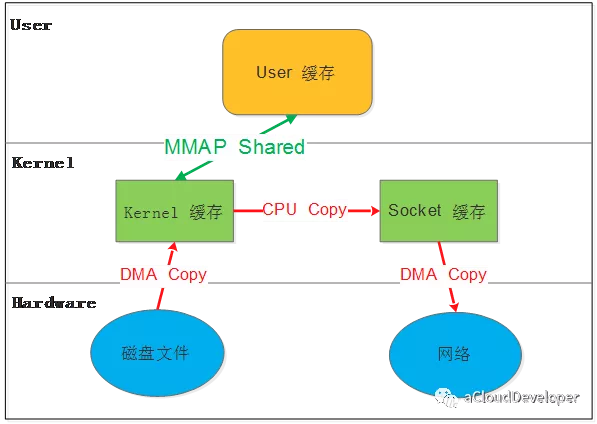spring中bean生命周期
但是当我第一次看到该图时,就产生了很多困扰,“Aware,……这些都是什么啊?而且这么多步骤,太多了,该怎么记啊?”。
其实要记忆该过程,还是需要我们先去理解,本文将从以下两方面去帮助理解 Bean 的生命周期:
生命周期的概要流程:对 Bean 的生命周期进行概括,并且结合代码来理解;
扩展点的作用:详细介绍 Bean 生命周期中所涉及到的扩展点的作用。
2. 生命周期的概要流程
Bean 的生命周期概括起来就是4 个阶段:
实例化:第 1 步,实例化一个 bean 对象;
属性赋值:第 2 步,为 bean 设置相关属性和依赖;初始化:第 3~7 步,步骤较多,其中第 5、6 步为初始化操作,第 3、4 步为在初始化前执行,第 7 步在初始化后执行,该阶段结束,才能被用户使用;销毁:第 8~10步,第8步不是真正意义上的销毁(还没使用呢),而是先在使用前注册了销毁的相关调用接口,为了后面第9、10步真正销毁 bean 时再执行相应的方法。
下面我们结合代码来直观的看下,在 () 方法中能看到依次执行了这 4 个阶段:
// AbstractAutowireCapableBeanFactory.java
protected Object doCreateBean(final String beanName, final RootBeanDefinition mbd, final @Nullable Object[] args)throws BeanCreationException {// 1. 实例化BeanWrapper instanceWrapper = null;if (instanceWrapper == null) {instanceWrapper = createBeanInstance(beanName, mbd, args);}Object exposedObject = bean;try {// 2. 属性赋值populateBean(beanName, mbd, instanceWrapper);// 3. 初始化exposedObject = initializeBean(beanName, exposedObject, mbd);}// 4. 销毁-注册回调接口try {registerDisposableBeanIfNecessary(beanName, bean, mbd);}return exposedObject;
}
由于初始化包含了第 3~7步,较复杂,所以我们进到 () 方法里具体看下其过程(注释的序号对应图中序号):
// AbstractAutowireCapableBeanFactory.java
protected Object initializeBean(final String beanName, final Object bean, @Nullable RootBeanDefinition mbd) {// 3. 检查 Aware 相关接口并设置相关依赖if (System.getSecurityManager() != null) {AccessController.doPrivileged((PrivilegedAction在 () 方法中会检查 接口和 init- 方法,销毁的过程也与其类似:
// DisposableBeanAdapter.java
public void destroy() {// 9. 若实现 DisposableBean 接口,则执行 destory()方法if (this.invokeDisposableBean) {try {if (System.getSecurityManager() != null) {AccessController.doPrivileged((PrivilegedExceptionAction从 的源码我们可以直观的看到其执行过程,而我们记忆其过程便可以从这 4 个阶段出发,实例化、属性赋值、初始化、销毁。其中细节较多的便是初始化,涉及了 Aware、、、init- 的概念。这些都是 提供的扩展点,其具体作用将在下一节讲述。
3. 扩展点的作用 3.1 Aware 接口
若 检测到 bean 实现了 Aware 接口,则会为其注入相应的依赖。所以通过让bean 实现 Aware 接口,则能在 bean 中获得相应的 容器资源。
中提供的 Aware 接口有:
:注入当前 bean 对应 ;:注入加载当前 bean 的 ;:注入 当前容器 的引用。
其代码实现如下:
// AbstractAutowireCapableBeanFactory.java
private void invokeAwareMethods(final String beanName, final Object bean) {if (bean instanceof Aware) {if (bean instanceof BeanNameAware) {((BeanNameAware) bean).setBeanName(beanName);}if (bean instanceof BeanClassLoaderAware) {((BeanClassLoaderAware) bean).setBeanClassLoader(bcl);}if (bean instanceof BeanFactoryAware) {((BeanFactoryAware) bean).setBeanFactory(AbstractAutowireCapableBeanFactory.this);}}
}
以上是针对 类型的容器,而对于 类型的容器,也提供了 Aware 接口,只不过这些 Aware 接口的注入实现,是通过 的方式注入的,但其作用仍是注入依赖。
:注入 ,一般用于获取配置属性;:注入 r( EL解析器),一般用于参数解析;are(、、):注入 容器本身。
其代码实现如下:
// ApplicationContextAwareProcessor.java
private void invokeAwareInterfaces(Object bean) {if (bean instanceof EnvironmentAware) {((EnvironmentAware)bean).setEnvironment(this.applicationContext.getEnvironment());}if (bean instanceof EmbeddedValueResolverAware) {((EmbeddedValueResolverAware)bean).setEmbeddedValueResolver(this.embeddedValueResolver);}if (bean instanceof ResourceLoaderAware) {((ResourceLoaderAware)bean).setResourceLoader(this.applicationContext);}if (bean instanceof ApplicationEventPublisherAware) {((ApplicationEventPublisherAware)bean).setApplicationEventPublisher(this.applicationContext);}if (bean instanceof MessageSourceAware) {((MessageSourceAware)bean).setMessageSource(this.applicationContext);}if (bean instanceof ApplicationContextAware) {((ApplicationContextAware)bean).setApplicationContext(this.applicationContext);}}
3.2
是 为修改 bean提供的强大扩展点,其可作用于容器中所有 bean,其定义如下:
public interface BeanPostProcessor {// 初始化前置处理default Object postProcessBeforeInitialization(Object bean, String beanName) throws BeansException {return bean;}// 初始化后置处理default Object postProcessAfterInitialization(Object bean, String beanName) throws BeansException {return bean;}}
常用场景有:
对于标记接口的实现类,进行自定义处理。例如3.1节中所说的,为其注入相应依赖;再举个例子,自定义对实现解密接口的类,将对其属性进行解密处理;为当前对象提供代理实现。例如 AOP 功能,生成对象的代理类,然后返回。
// AbstractAutoProxyCreator.java
public Object postProcessBeforeInstantiation(Class beanClass, String beanName) {TargetSource targetSource = getCustomTargetSource(beanClass, beanName);if (targetSource != null) {if (StringUtils.hasLength(beanName)) {this.targetSourcedBeans.add(beanName);}Object[] specificInterceptors = getAdvicesAndAdvisorsForBean(beanClass, beanName, targetSource);Object proxy = createProxy(beanClass, beanName, specificInterceptors, targetSource);this.proxyTypes.put(cacheKey, proxy.getClass());// 返回代理类return proxy;}return null;
}
3.3 和 init-
和 init- 是 为bean 初始化提供的扩展点。
接口 的定义如下:
public interface InitializingBean {void afterPropertiesSet() throws Exception;
}
在 () 方法写初始化逻辑。
指定 init- 方法,指定初始化方法:
和 - 与上述类似,就不描述了。
4. 总结
最后总结下如何记忆 Bean 的生命周期:












